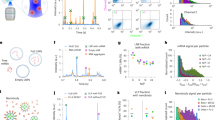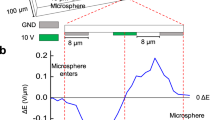Abstract
Synthetic nanoparticles and genetically modified viruses are used in a range of applications, but high-throughput analytical tools for the physical characterization of these objects are needed. Here we present a microfluidic analyser that detects individual nanoparticles and characterizes complex, unlabelled nanoparticle suspensions. We demonstrate the detection, concentration analysis and sizing of individual synthetic nanoparticles in a multicomponent mixture with sufficient throughput to analyse 500,000 particles per second. We also report the rapid size and titre analysis of unlabelled bacteriophage T7 in both salt solution and mouse blood plasma, using just ∼1 × 10−6 l of analyte. Unexpectedly, in the native blood plasma we discover a large background of naturally occurring nanoparticles with a power-law size distribution. The high-throughput detection capability, scalable fabrication and simple electronics of this instrument make it well suited for diverse applications.
This is a preview of subscription content, access via your institution
Access options
Subscribe to this journal
Receive 12 print issues and online access
$259.00 per year
only $21.58 per issue
Buy this article
- Purchase on Springer Link
- Instant access to full article PDF
Prices may be subject to local taxes which are calculated during checkout






Similar content being viewed by others
References
Nohynek, G. J., Lademann, J., Ribaud, C. & Roberts, M. S. Grey goo on the skin? Nanotechnology, cosmetic and sunscreen safety. Crit. Rev. Toxicol 37, 251–277 (2007).
Franzman, M. A., Schlenker, C. W., Thompson, M. E. & Brutchey, R. L. Solution-phase synthesis of SnSe nanocrystals for use in solar cells. J. Am. Chem. Soc. 132, 4060–4061 (2010).
Sugahara, K. N. et al. Tissue-penetrating delivery of compounds and nanoparticles into tumors. Cancer Cell 16, 510–520 (2009).
Michalet, X. et al. Quantum dots for live cells, in vivo imaging, and diagnostics. Science 307, 538–544 (2005).
Harisinghani, M. G. et al. Noninvasive detection of clinically occult lymph-node metastases in prostate cancer. New Engl. J. Med. 348, 2491–2499 (2003).
VanWijk, M. J., VanBavel, E., Sturk, A. & Nieuwland, R. Microparticles in cardiovascular diseases. Cardiovasc. Res. 59, 277–287 (2003).
Valadi, H. et al. Exosome-mediated transfer of mRNAs and microRNAs is a novel mechanism of genetic exchange between cells. Nature Cell. Biol. 9, 654–659 (2007).
Simons, M. & Raposo, G. Exosomes—vesicular carriers for intercellular communication. Curr. Opin. Cell Biol. 21, 575–581 (2009).
WHO. World Health Statistics 2010 (WHO, 2010).
Cressey, D. Tiny traits cause big headaches. Nature 467, 264–265 (2010).
Nel, A., Xia, T., Madler, L. & Li, N. Toxic potential of materials at the nanolevel. Science 311, 622–627 (2006).
Maynard, A. D. et al. Safe handling of nanotechnology. Nature 444, 267–269 (2006).
Coulter, W. H. Means for counting particles suspended in a fluid. US patent 2,656,508 (1953).
DeBlois, R. W. & Bean, C. P. Counting and sizing of submicron particles by the resistive pulse technique. Rev. Sci. Instrum. 41, 909–916 (1970).
Kasianowicz, J. J., Brandin, E., Branton, D. & Deamer, D. W. Characterization of individual polynucleotide molecules using a membrane channel. Proc. Natl Acad. Sci. USA 93, 13770–13773 (1996).
Li, J., Gershow, M., Stein, D., Brandin, E. & Golovchenko, J. A. DNA molecules and configurations in a solid-state nanopore microscope. Nature Mater. 2, 611–615 (2003).
Uram, J. D., Ke, K., Hunt, A. J. & Mayer, M. Label-free affinity assays by rapid detection of immune complexes in submicrometer pores. Angew. Chem. Int. Ed. 45, 2281–2285 (2006).
Saleh, O. A. & Sohn, L. L. An artificial nanopore for molecular sensing. Nano Lett. 3, 37–38 (2003).
Sen, Y-H. & Karnik, R. Investigating the translocation of λ-DNA molecules through PDMS nanopores. Anal. Bioanal. Chem. 394, 437–446 (2009).
Bard, A. J. Electrochemical Methods Fundamentals and Applications 2nd edn (Wiley, 1980).
Sridhar, M. et al. Experimental characterization of a metal-oxide-semiconductor field-effect transistor-based coulter counter. J. Appl. Phys. 103, 104701 (2008).
Uram, J. D., Ke, K., Hunt, A. J. & Mayer, M. Submicrometer pore-based characterization and quantification of antibody–virus interactions. Small 2, 967–972 (2006).
Saleh, O. A. & Sohn, L. L. Quantitative sensing of nanoscale colloids using a microchip Coulter counter. Rev. Sci. Instrum. 72, 4449–4451 (2001).
Berne, B. J. Dynamic Light Scattering: With Applications to Chemistry, Biology, and Physics (Wiley, 1976).
Teesalu, T., Sugahara, K. N., Kotamraju, V. R. & Ruoslahti, E. C-end rule peptides mediate neuropilin-1-dependent cell, vascular, and tissue penetration. Proc. Natl Acad. Sci. USA 106, 16157–16162 (2009).
Wakita, T. et al. Production of infectious hepatitis C virus in tissue culture from a cloned viral genome. Nature Med. 11, 791–796 (2005).
Davison, P. F. & Freifelder, D. The physical properties of T7 bacteriophage. J. Mol. Biol. 5, 635–642, IN2 (1962).
Ronto, G., Agamalyan, M. M., Drabkin, G. M., Feigin, L. A. & Lvov, Y. M. Structure of bacteriophage-T7—small-angle X-ray and neutron-scattering study. Biophys. J. 43, 309–314 (1983).
Serwer, P. Buoyant density sedimentation of macromolecules in sodium iothalamate density gradients. J. Mol. Biol. 92, 433–448 (1975).
Stroud, R. M., Serwer, P. & Ross, M. J. Assembly of bacteriophage-T7—dimensions of the bacteriophage and its capsids. Biophys. J. 36, 743–757 (1981).
Berg, T. et al. Prediction of treatment outcome in patients with chronic hepatitis C: significance of baseline parameters and viral dynamics during therapy. Hepatology 37, 600–609 (2003).
Caby, M-P., Lankar, D., Vincendeau-Scherrer, C., Raposo, G. & Bonnerot, C. Exosomal-like vesicles are present in human blood plasma. Int. Immunol. 17, 879–887 (2005).
Kiser, M. A. et al. Titanium nanomaterial removal and release from wastewater treatment plants. Environ. Sci. Technol. 43, 6757–6763 (2009).
Gottschalk, F., Sonderer, T., Scholz, R. W. & Nowack, B. Modeled environmental concentrations of engineered nanomaterials (TiO2, ZnO, Ag, CNT, fullerenes) for different regions. Environ. Sci. Technol. 43, 9216–9222 (2009).
Duffy, D., McDonald, J., Schueller, O. & Whitesides, G. Rapid prototyping of microfluidic systems in poly(dimethylsiloxane). Anal. Chem. 70, 4974–4984 (1998).
Fraikin, J-L., Requa, M. V. & Cleland, A. N. Probing the Debye layer: capacitance and potential of zero charge measured using a Debye-layer transistor. Phys. Rev. Lett. 102, 156601 (2009).
Wood, D. K., Oh, S-H., Lee, S-H., Soh, H. T. & Cleland, A. N. High-bandwidth radio frequency Coulter counter. Appl. Phys. Lett. 87, 184106 (2005).
Wood, D. K., Requa, M. V. & Cleland, A. N. Microfabricated high-throughput electronic particle detector. Rev. Sci. Instrum. 78, 104301 (2007).
Wood, D. K. et al. A feasible approach to all-electronic digital labeling and readout for cell identification. Lab Chip 7, 469–474 (2007).
Kubitscheck, H. E. Counting and Sizing Micro-organisms with the Coulter Counter Vol. 1, Ch. XXVII, 593–610 (Academic, 1969).
Acknowledgements
This research was supported by a National Institutes of Health Program of Excellence in Nanotechnology grant (U01-HL080718). The authors thank C. Axline for construction of the pressure manifold used to control flow in the microfluidic system, and G. Braun for valuable discussions. The authors also acknowledge use of the UC Santa Barbara Nanofabrication Facility, a part of the NSF-supported National Nanofabrication Infrastructure Network (NNIN).
Author information
Authors and Affiliations
Contributions
J.-L.F. fabricated the analyser, performed the experiments and analysed the data. J.-L.F. and A.N.C designed the analyser. J.-L.F., T.T. and A.N.C. designed the experiments with contributions from E.R. J.-L.F. and A.N.C. wrote the manuscript with contributions from T.T. T.T. performed the biological procedures, including phage synthesis. C.M.M. contributed to the fabrication of the fluidic mold.
Corresponding author
Ethics declarations
Competing interests
The authors declare no competing financial interests.
Supplementary information
Supplementary information
Supplementary information (PDF 733 kb)
Rights and permissions
About this article
Cite this article
Fraikin, JL., Teesalu, T., McKenney, C. et al. A high-throughput label-free nanoparticle analyser. Nature Nanotech 6, 308–313 (2011). https://doi.org/10.1038/nnano.2011.24
Received:
Accepted:
Published:
Issue Date:
DOI: https://doi.org/10.1038/nnano.2011.24
This article is cited by
-
Utilising extracellular vesicles for early cancer diagnostics: benefits, challenges and recommendations for the future
British Journal of Cancer (2022)
-
Storage conditions determine the characteristics of red blood cell derived extracellular vesicles
Scientific Reports (2022)
-
Synchronized resistive-pulse analysis with flow visualization for single micro- and nanoscale objects driven by optical vortex in double orifice
Scientific Reports (2021)
-
Impact of isolation methods on the biophysical heterogeneity of single extracellular vesicles
Scientific Reports (2020)
-
Detection and phenotyping of extracellular vesicles by size exclusion chromatography coupled with on-line fluorescence detection
Scientific Reports (2019)



